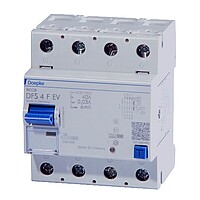The DFS4 F EV from Doepke protects the charging point and the entire system
Electromobility is taking off: buyers are increasingly opting for electric vehicles in both the semi-public and private sectors. This is opening up a lucrative future market for electrical specialists, as each of these vehicles needs a charging point. Whether this takes the form of a charging pole on a driveway, a wall-mounted charger – known as a wall box – in the garage or a household mains socket: electricians are responsible for installing the charging point, from connecting it to the mains through to commissioning it. Particular regulations must be complied with regarding protection, as smooth DC residual currents can occur when charging an electric car.
Doepke has developed the new DFS4 F EV (EV stands for “electric vehicles”) mixed-frequency-sensitive residual current circuit-breaker specifically for protecting charging points against these DC residual currents. By using this product, electricians can always stay on the safe side: it not only detects AC residual currents and pulsating DC residual currents, but also residual currents with mixed frequencies deviating from 50 Hz. What is special about the EV model is its integrated DC residual current detection. Because of this, the new residual current circuit-breaker trips reliably if smooth DC residual currents higher than 6 mA occur when an electric car is charged.
DFS 4 F EV maintains the whole system’s protective functions
The smooth DC residual current detection has been integrated into just 4 module widths in the DFS 4 F EV. The unit is easy to install and protects the charging point, as well as any upstream residual current circuit-breakers without DC residual current protection, against blinding: no additional wiring work or extra space is required. If, for example, a regular type A or F residual current circuit-breaker is connected upstream in the power distributor, this does not pose a problem as the DFS 4 F EV can simply be placed downstream of it. In addition, it has greater immunity to surge currents up to 3 kA, and is also lightning-resistant due to its short time delay. This reduces unwanted tripping overall.
